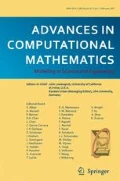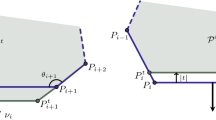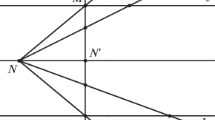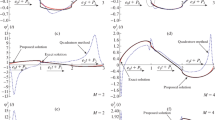Abstract
The classic eigenvalue problem of the Laplace operator inside a variety of polygons is numerically solved by using a method nearly identical to that used by Fox, Henrici, and Moler in their 1967 paper. It is demonstrated that such eigenvalue calculations can be extended to unprecedented precision, often to well over a hundred digits, or even thousands of digits. To work well, geometric symmetry must be exploited. The de-symmetrized fundamental domains (usually triangular) considered here have at most one non-analytic vertex. Dirichlet, Neumann, and periodic-type edge conditions are independently imposed on each symmetry-reduced polygon edge. The method of particular solutions is used whereby an eigenfunction is expanded in an N-term Fourier-Bessel series about the non-analytic vertex and made to match at a set of N points on the boundary. Under the right conditions, the so-called point-matching determinant has roots that approximate eigenvalues. A key observation is that by increasing the number of terms in the expansion, the approximate eigenvalue may be made to alternate above and below, while approaching what is presumed to be the exact eigenvalue. This alternation effectively provides a new method to bound eigenvalues, by inspection. Specific examples include Dirichlet and Neumann eigenvalues within polygons with re-entrant angles (L-shape, cut-square, 5-point star) and the regular polygons. Thousand-digit results are reported for the lowest Dirichlet eigenvalues of the L-shape, and regular pentagon and hexagon.
Similar content being viewed by others
References
Amore, P., Boyd, J.P., Fernandez, F.M., Rosler, B.: High order eigenvalues for the Helmholtz equation in complicated non-tensor domains through Richardson Extrapolation of second order finite differences. 2015. arXiv:1509.02795
Barnett, A., Hassell, A. : Fast computation of high frequency Dirichlet eigenmodes via spectral flow of the interior Neumann-to-Dirichlet map. Comm. Pure Appl. Math. 67(3), 351–407 (2014). More recent reference to MPSpack
Barnett A.H., Betcke T.: An exponentially convergent nonpolynomial finite element method for time-harmonic scattering from polygons. SIAM J. Sci. Comp. 32 (3), 1417–1441 (2010) http://code.google.com/p/mpspack
Barta, J.: Über die näherungsweise Lösung eigiger zweidimensionaler Elastizitätsaufgaben. Zeitschrift für angewandte Mathematik und Mechanik 17, 184 (1937)
Bauer, L., Reiss, E.L.: Cutoff wavenumbers and modes of hexagonal waveguides. SIAM J. of Appl. Math. 35, 508–514 (1978)
Betcke, T., Trefethen, L.N.: Reviving the method of particular solutions. SIAM Rev. 47, 469–491 (2004)
Boady, M.: Applications of Symbolic Computation to the Calculus of Moving Surfaces. PhD thesis, Drexel University, Philadelphia, PA (2015)
Conway, H.D.: The bending, buckling, and flexural vibrations of simply supported polygonal plates by point matching. Trans. ASME J. Appl. Mech. 83E, 288–291 (1961)
Cureton, L.M., Kuttler, J.R.: Eigenvalues of the Laplacian on regular polygons and polygons resulting from their dissection. J. Sound Vib. 220, 83–98 (1998)
Fox, L., Henrici, P., Moler, C.: Approximation and bounds for eigenvalues of elliptic operators. SIAM J. Numer. Anal. 4, 89–102 (1967)
Torbjörn Granlund and the GMP development team: GNU MP: The GNU Multiple Precision Arithmetic Library 6.0.0 edition (2015). Available online http://gmplib.org/
Guidotti, P., Lambers, J.V.: Eigenvalue characterization and computation for the Laplacian on general 2-D domains. Numer. Funct. Anal. Optim. 29, 507–531 (2008)
Hersch, J.: Erweiterte symmetrieeigenschaften von lösungen gewisser linearer rand- und eigenwertprobleme. J. reine angew. Math. 218, 143–158 (1965)
Hillairet, L., Judge, C.: Generic spectral simplicity of polygons. Proc. Amer. Math. Soc. 137, 2139–2145 (2009)
Jones, R.S.: The one-dimensional three-body problem and selected waveguide problems: solutions of the two-dimensional Helmholtz equation . PhD thesis, The Ohio State University (1993)
Kuttler, J.R., Sigillito, V.G.: Eigenvalues of the Laplacian in two dimensions. SIAM Rev. 26, 163–193 (1984)
Lanz, C.: The use of Schwarz-Christoffel transformations in determining acoustic resonances. Master’s thesis, Virginia Polytechnic Institute and State University (2010)
Maxima: Maxima, a Computer Algebra System. Version 5.31 (2015). http://maxima.sourceforge.net/
Moler, C.B., Payne, L.E.: Bounds for eigenvalues and eigenvectors of symmetric operators. SIAM J. Numer. Anal. 5, 64–70 (1968)
Oikonomoum, V.K.: Casimir energy for a regular polygon with Dirichlet boundaries. 2010. arXiv:1012.5376
Sloane, N.J.A.: The On-Line Encyclopedia of Integer Sequences, 2010. Published electronically at http://oeis.org
Strang, G., Grinfeld, P.: The Laplacian eigenvalues of a polygon. Computers and Mathematics with Applications 48, 1121–1133 (2004)
The PARI Group: Bordeaux. PARI/GP version 2.7.3 (2015). Available online http://pari.math.u-bordeaux.fr/
Trefethen, L.N., Betcke, T.: Computed eigenmodes of planar regions. Contemp. Math., Amer. Math. Soc. 412, 297–314 (2006)
Yuan, Q., He, Z.: Bounds to eigenvalues of the Laplacian on L-shaped domain by variational methods. J. Comp. Appl. Math. 233, 1083–1090 (2009)
Acknowledgements
I wish to thank Alex Barnett for making the specific suggestion to expand about the non-analytic vertex using fractional-order Bessel functions, i.e., non-integral m-values (private communication, December 2014). Indeed, after sharing some regular pentagon results with him, he suggested that instead of expanding about the center of the regular pentagon, I should expand about one of its vertices. That one simple, and—in hind-sight—obvious suggestion, immediately turned my eight-digit calculations into multi-hundred-digit calculations because of the exponential convergence. I also wish to thank James Kuttler and Nick Trefethen for suggestions and encouragement. I am also encouraged by the recent independent efforts of Mark Boady and Paolo Amore, et al., and wish to thank them for interesting dialogs. Of course, this project was made possible by free software, most specifically GMP [11] and the GP/PARI [23] calculator.
Author information
Authors and Affiliations
Corresponding author
Additional information
Communicated by: Alexander Barnett
Rights and permissions
About this article
Cite this article
Jones, R.S. Computing ultra-precise eigenvalues of the Laplacian within polygons. Adv Comput Math 43, 1325–1354 (2017). https://doi.org/10.1007/s10444-017-9527-y
Received:
Accepted:
Published:
Issue Date:
DOI: https://doi.org/10.1007/s10444-017-9527-y
Keywords
- Laplacian eigenvalue
- Helmholtz equation
- Method of particular solutions
- Point-matching method
- Polygon
- Eigenvalue bound




